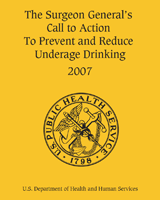NCBI Bookshelf. A service of the National Library of Medicine, National Institutes of Health.
Office of the Surgeon General (US); National Institute on Alcohol Abuse and Alcoholism (US); Substance Abuse and Mental Health Services Administration (US). The Surgeon General's Call to Action To Prevent and Reduce Underage Drinking. Rockville (MD): Office of the Surgeon General (US); 2007.
Alcohol is the most widely used substance of abuse among America's youth. A higher percentage of young people between the ages of 12 and 20 use alcohol than use tobacco or illicit drugs. The physical consequences of underage alcohol use range from medical problems to death by alcohol poisoning, and alcohol plays a significant role in risky sexual behavior, physical and sexual assaults, various types of injuries, and suicide. Underage drinking also creates secondhand effects for others, drinkers and nondrinkers alike, including car crashes from drunk driving, that put every child at risk. Underage alcohol consumption is a major societal problem with enormous health and safety consequences and will demand the Nation's attention and committed efforts to solve.
For the most part, parents and other adults underestimate the number of adolescents who use alcohol. They underestimate how early drinking begins, the amount of alcohol adolescents consume, the many risks that alcohol consumption creates for adolescents, and the nature and extent of the consequences to both drinkers and nondrinkers. Too often, parents are inclined to believe, “Not my child.” Yet, by age 15, approximately one-half of America's boys and girls have had a whole drink of alcohol, not just a few sips, and the highest prevalence of alcohol dependence in any age group is among people ages 18 to 20.
I have issued this Surgeon General's Call to Action To Prevent and Reduce Underage Drinking to focus national attention on this enduring problem and on new, disturbing research which indicates that the developing adolescent brain may be particularly susceptible to long-term negative consequences from alcohol use. Recent studies show that alcohol consumption has the potential to trigger long-term biological changes that may have detrimental effects on the developing adolescent brain, including neurocognitive impairment.
Fortunately, the latest research also offers hopeful new possibilities for prevention and intervention by furthering our understanding of underage alcohol use as a developmental phenomenon—as a behavior directly related to maturational processes in adolescence. New research explains why adolescents use alcohol differently from adults, why they react uniquely to it, and why alcohol can pose such a powerful attraction to adolescents, with unpredictable and potentially devastating outcomes.
Emerging research also makes it clear that an adolescent's decision to use alcohol is influenced by multiple factors. These factors include normal maturational changes that all adolescents experience; genetic, psychological, and social factors specific to each adolescent; and the various social and cultural environments that surround adolescents, including their families, schools, and communities. These factors—some of which protect adolescents from alcohol use and some of which put them at risk— change during the course of adolescence. Because environmental factors play such a significant role, responsibility for the prevention and reduction of underage drinking extends beyond the parents of adolescents, their schools, and communities. It is the collective responsibility of the Nation as a whole and of each of us individually.
The process of solving the public health problem of underage alcohol use begins with an examination of our own attitudes toward underage drinking—and our recognition of the seriousness of its consequences for adolescents, their families, and society as a whole. Adolescent alcohol use is not an acceptable rite of passage but a serious threat to adolescent development and health, as the statistics related to adolescent impairment, injury, and death attest.
A significant point of the Call to Action is this: Underage alcohol use is not inevitable, and schools, parents, and other adults are not powerless to stop it. The latest research demonstrates a compelling need to address alcohol use early, continuously, and in the context of human development using a systematic approach that spans childhood through adolescence into adulthood. Such an approach is described in this Call to Action. Such an approach can be effective when, as a Nation and individually, we commit ourselves to solving the problem of underage drinking in America. We owe nothing less to our children and our country.
Kenneth P. Moritsugu, M.D., M.P.H.
- Foreword From the Acting Surgeon General, U.S. Department of Health and Human Se...Foreword From the Acting Surgeon General, U.S. Department of Health and Human Services - The Surgeon General's Call to Action To Prevent and Reduce Underage Drinking
- sagG [Streptococcus pyogenes MGAS10270]sagG [Streptococcus pyogenes MGAS10270]Gene ID:4063476Gene
- VNG_RS05655 [Halobacterium salinarum NRC-1]VNG_RS05655 [Halobacterium salinarum NRC-1]Gene ID:1448059Gene
- OAF3 Oaf3p [Saccharomyces cerevisiae S288C]OAF3 Oaf3p [Saccharomyces cerevisiae S288C]Gene ID:853938Gene
Your browsing activity is empty.
Activity recording is turned off.
See more...
